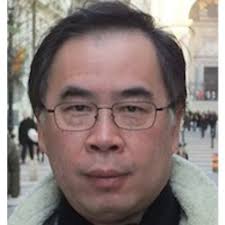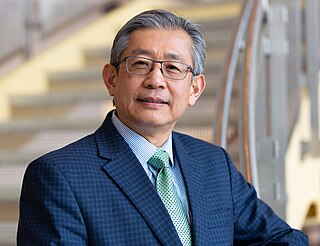Related Research Articles
Steganography is the practice of representing information within another message or physical object, in such a manner that the presence of the information is not evident to human inspection. In computing/electronic contexts, a computer file, message, image, or video is concealed within another file, message, image, or video. The word steganography comes from Greek steganographia, which combines the words steganós, meaning "covered or concealed", and -graphia meaning "writing".
A digital watermark is a kind of marker covertly embedded in a noise-tolerant signal such as audio, video or image data. It is typically used to identify ownership of the copyright of such signal. "Watermarking" is the process of hiding digital information in a carrier signal; the hidden information should, but does not need to, contain a relation to the carrier signal. Digital watermarks may be used to verify the authenticity or integrity of the carrier signal or to show the identity of its owners. It is prominently used for tracing copyright infringements and for banknote authentication.

Tradecraft, within the intelligence community, refers to the techniques, methods, and technologies used in modern espionage (spying) and generally as part of the activity of intelligence assessment. This includes general topics or techniques, or the specific techniques of a nation or organization.

Kamisetty Ramamohan Rao was an Indian-American electrical engineer. He was a professor of Electrical Engineering at the University of Texas at Arlington. Academically known as K. R. Rao, he is credited with the co-invention of discrete cosine transform (DCT), along with Nasir Ahmed and T. Natarajan due to their landmark publication, Discrete Cosine Transform.
Ali Naci Akansu is a Turkish-American professor of electrical & computer engineering and scientist in applied mathematics.

Anastasios (Tas) Venetsanopoulos was a professor of electrical and computer engineering at Toronto Metropolitan University in Toronto, Ontario and a professor emeritus with the Edward S. Rogers Department of Electrical and Computer Engineering at the University of Toronto. In October 2006, Venetsanopoulos joined what was then Ryerson University and served as the founding vice-president of research and innovation. His portfolio included oversight of the university's international activities, research ethics, Office of Research Services, and Office of Innovation and Commercialization. He retired from that position in 2010, but remained a distinguished advisor to the role. Tas Venetsanopoulos continued to actively supervise his research group at the University of Toronto, and was a highly sought-after consultant throughout his career.
Hardware obfuscation is a technique by which the description or the structure of electronic hardware is modified to intentionally conceal its functionality, which makes it significantly more difficult to reverse-engineer. In other words, hardware obfuscation modifies the design in such a away that the resulting architecture becomes un-obvious to an adversary. Hardware Obfuscation can be of two types depending on the hardware platform targeted: (a) DSP Core Hardware Obfuscation - this type of obfuscation performs certain high level transformation on the data flow graph representation of DSP core to convert it into an unknown form that reflects an un-obvious architecture at RTL or gate level. This type of obfuscation is also called 'Structural Obfuscation'. Another type of DSP Core Obfuscation method is called 'Functional Obfuscation' - It uses a combination of AES and IP core locking blocks (ILBs) to lock the functionality of the DSP core using key-bits. Without application of correct key sequence, the DSP core produces either wrong output or no output at all (b) Combinational/Sequential Hardware Obfuscation - this type of obfuscation performs changes to the gate level structure of the circuit itself.

A steganography software tool allows a user to embed hidden data inside a carrier file, such as an image or video, and later extract that data.
Ingemar J. Cox is Professor and Director of Research in the Department of Computer Science at University College London, where he is Head of the Future Media Group, and he is Professor in the Machine Learning department at the University of Copenhagen. Between 2003 and 2008, he was Director of UCL's Adastral Park Campus.

Saraju Mohanty is an Indian-American professor of the Department of Computer Science and Engineering, and the director of the Smart Electronic Systems Laboratory, at the University of North Texas in Denton, Texas. Mohanty received a Glorious India Award – Rich and Famous NRIs of America in 2017 for his contributions to the discipline. Mohanty is a researcher in the areas of "smart electronics for smart cities/villages", "smart healthcare", "application-Specific things for efficient edge computing", and "methodologies for digital and mixed-signal hardware". He has made significant research contributions to security by design (SbD) for electronic systems, hardware-assisted security (HAS) and protection, high-level synthesis of digital signal processing (DSP) hardware, and mixed-signal integrated circuit computer-aided design and electronic design automation. Mohanty has been the editor-in-chief (EiC) of the IEEE Consumer Electronics Magazine during 2016-2021. He has held the Chair of the IEEE Computer Society's Technical Committee on Very Large Scale Integration during 2014-2018. He holds 4 US patents in the areas of his research, and has published 500 research articles and 5 books. He is ranked among top 2% faculty around the world in Computer Science and Engineering discipline as per the standardized citation metric adopted by the Public Library of Science Biology journal.
Nasir Memon is a computer scientist based in Brooklyn, New York. Memon is a professor and chair of the New York University Tandon School of Engineering computer science and engineering department and affiliate faculty at the computer science department in the Courant Institute of Mathematical Sciences at New York University. He is also the Department Head of NYU Tandon Online, the online learning unit of the school. He introduced cyber security studies to New York University Tandon School of Engineering, making it one of the first schools to implement the program at the undergraduate level. Memon holds twelve patents in image compression and security. He is the founding director of the Center for Interdisciplinary Studies in Security and Privacy (CRISSP) and CRISSP Abu Dhabi. In 2002, Memon founded Cyber Security Awareness Week (CSAW), an annual conference where tens of thousands of students compete in events and learn skills in cyber security Memon is also co-founder of Digital Assembly, a software company that develops digital forensics and data recovery and Vivic, a company that produces malware detection software. Memon has published over 250 articles in journals and conferences and has contributed to articles regarding cyber security in magazines such as Crain’s New York Business, Fortune, and USA Today. His research has been featured in NBC Nightly News, The New York Times, MIT Review, Wired.Com, and New Science Magazine.
Hong-yuan Mark Liao is a Taiwanese computer scientist specialized in the field of multimedia information processing and AI.
Shih-Fu Chang is a Taiwanese American computer scientist and electrical engineer noted for his research on multimedia information retrieval, computer vision, machine learning, and signal processing.

Prof. Anthony TS Ho (何东旋教授) FIET, FInstP, FBCS, CEng, CPhys is a British computer scientist and Professor of Multimedia Security at the University of Surrey.
Hardware watermarking, also known as IP core watermarking is the process of embedding covert marks as design attributes inside a hardware or IP core design itself. Hardware Watermarking can represent watermarking of either DSP Cores or combinational/sequential circuits. Both forms of Hardware Watermarking are very popular. In DSP Core Watermarking a secret mark is embedded within the logic elements of the DSP Core itself. DSP Core Watermark usually implants this secret mark in the form of a robust signature either in the RTL design or during High Level Synthesis (HLS) design. The watermarking process of a DSP Core leverages on the High Level Synthesis framework and implants a secret mark in one of the high level synthesis phases such as scheduling, allocation and binding. DSP Core Watermarking is performed to protect a DSP core from hardware threats such as IP piracy, forgery and false claim of ownership. Some examples of DSP cores are FIR filter, IIR filter, FFT, DFT, JPEG, HWT etc. Few of the most important properties of a DSP core watermarking process are as follows: (a) Low embedding cost (b) Secret mark (c) Low creation time (d) Strong tamper tolerance (e) Fault tolerance.
A copy detection pattern (CDP) or graphical code is a small random or pseudo-random digital image which is printed on documents, labels or products for counterfeit detection. Authentication is made by scanning the printed CDP using an image scanner or mobile phone camera. It is possible to store additional product-specific data into the CDP that will be decoded during the scanning process. A CDP can also be inserted into a 2D barcode to facilitate smartphone authentication and to connect with traceability data.

K. J. Ray Liu is an American scientist, engineer, educator, and entrepreneur. He is the founder, former Chief Executive Officer, and now Chairman and Chief Technology Officer of Origin Wireless, Inc., which pioneers artificial intelligence analytics for wireless sensing and indoor tracking.
Minerva Yeung is an American research scientist and educator best known for her work in video processing, multimedia information systems, and digital watermarking.
Min Wu is a Chinese-American electrical engineer and an expert in signal processing, digital forensics, digital watermarking, and steganography. She is Christine Yurie Kim Eminent Professor in Information Technology and Associate Dean for Graduate Affairs in the A. James Clark School of Engineering at the University of Maryland, College Park, the former editor-in-chief of IEEE Signal Processing Magazine, the former chair of the IEEE Information Forensics and Security Technical Committee, and the president of the IEEE Signal Processing Society.
References
- ↑ "Visual Information Processing and Protection Group".
- ↑ Lu, Chun-Shien (31 July 2004). Multimedia Security: Steganography and Digital Watermarking Techniques for Protection of Intellectual Property: Steganography and Digital Watermarking Techniques for Protection of Intellectual Property. Idea Group Inc (IGI). ISBN 9781591401933.
- ↑ "IEEE Fellows 2012".